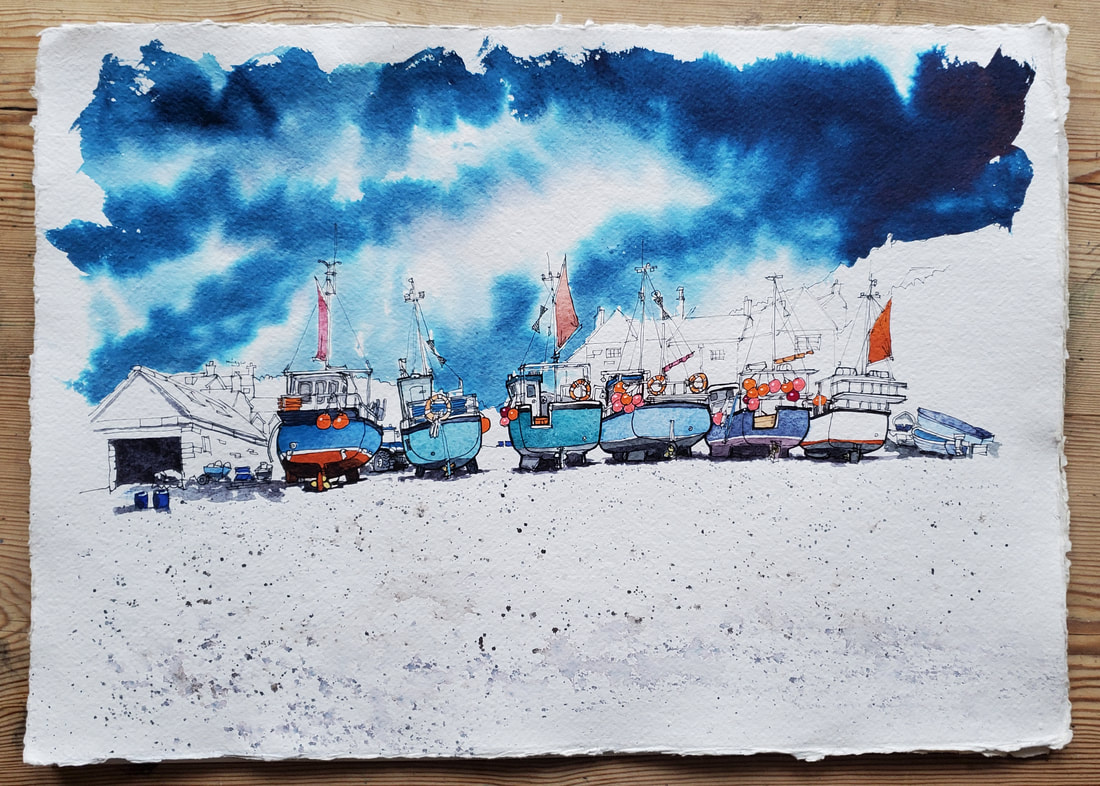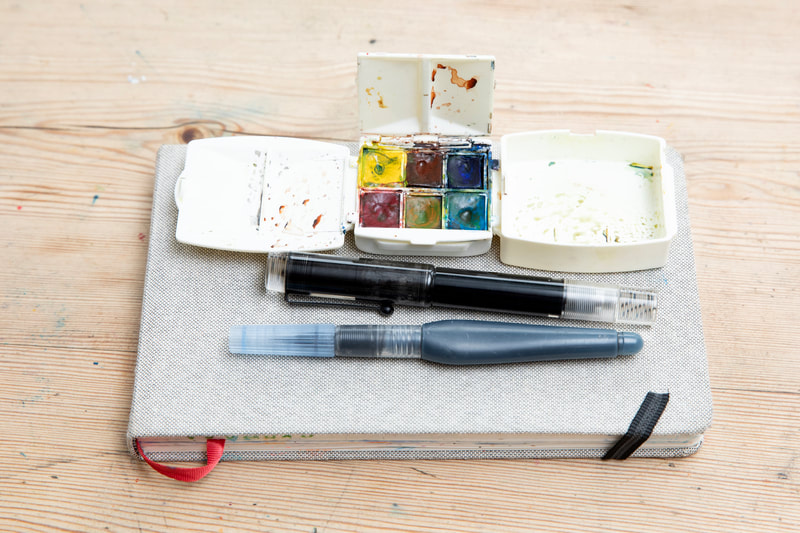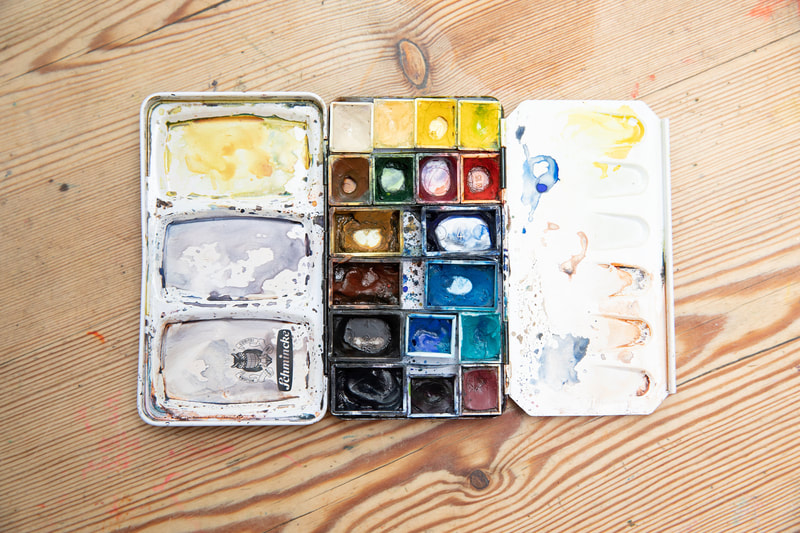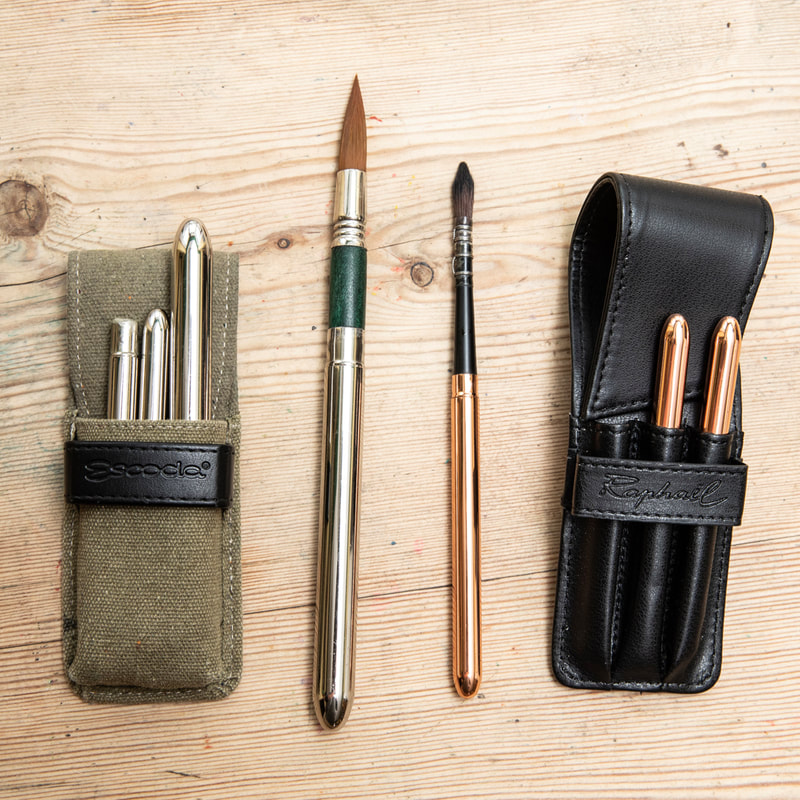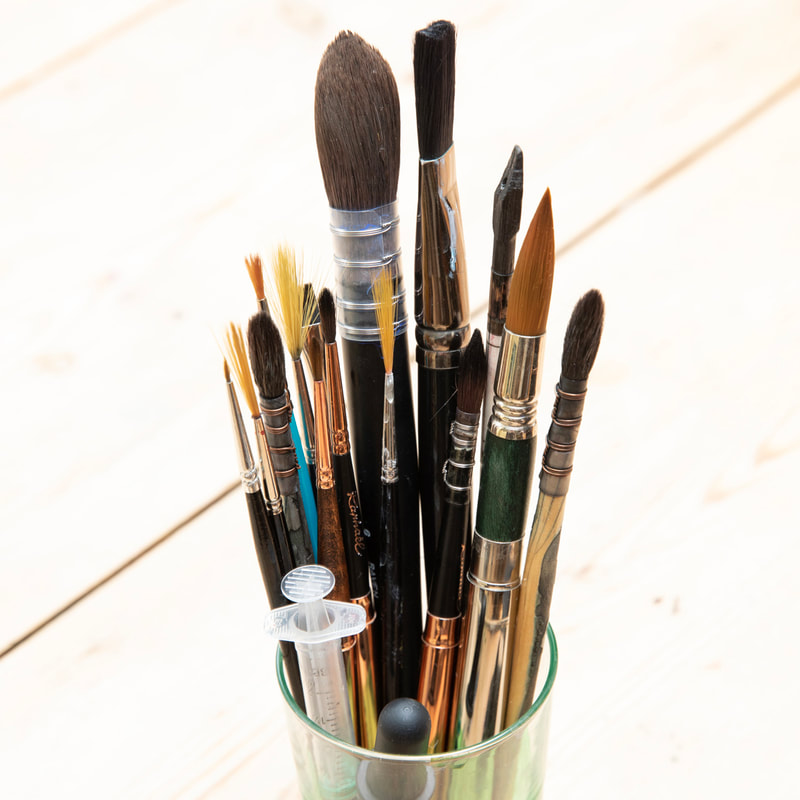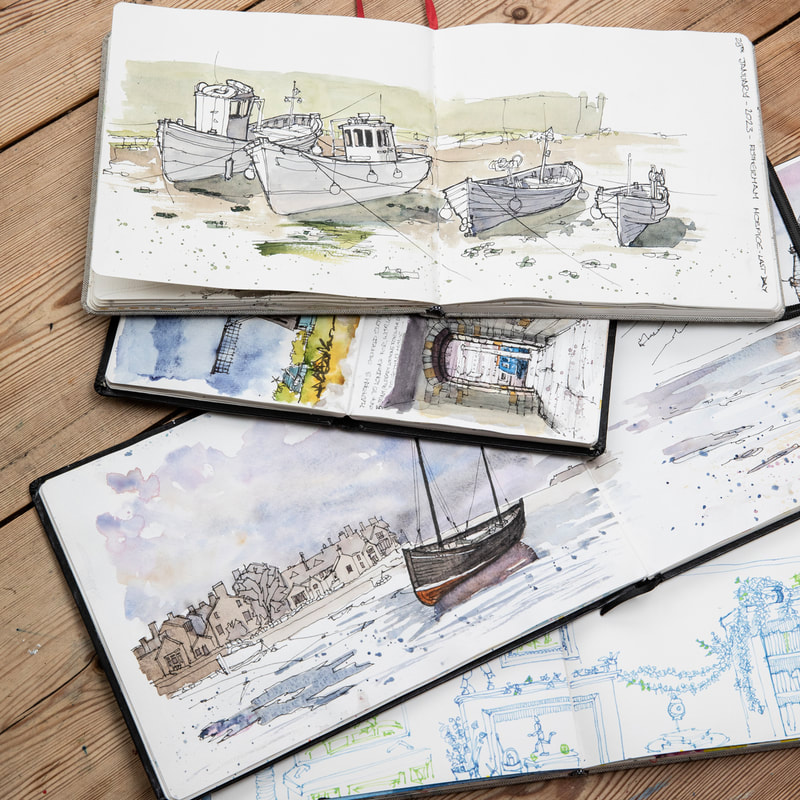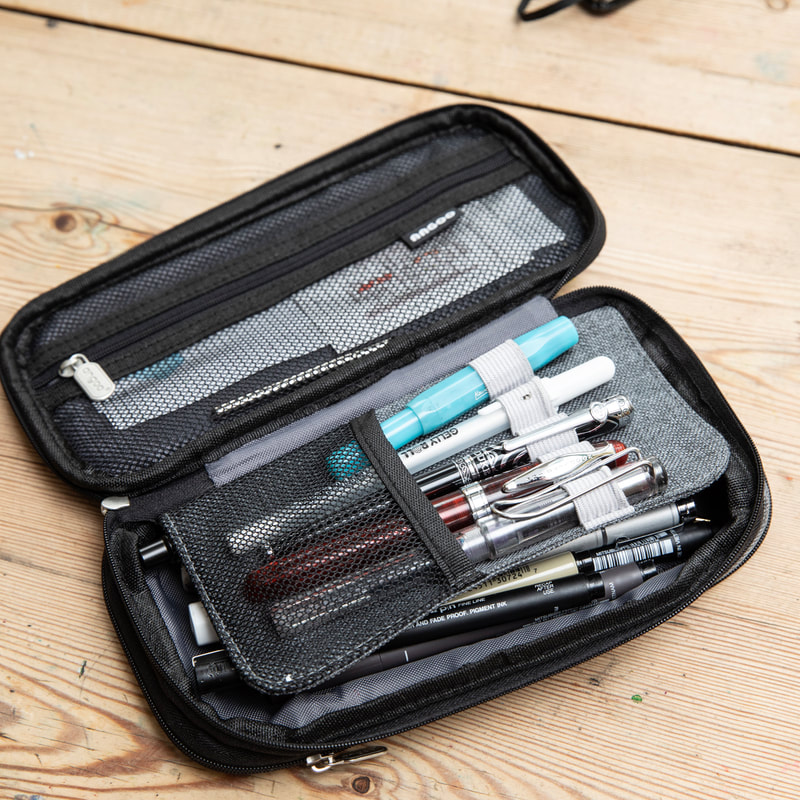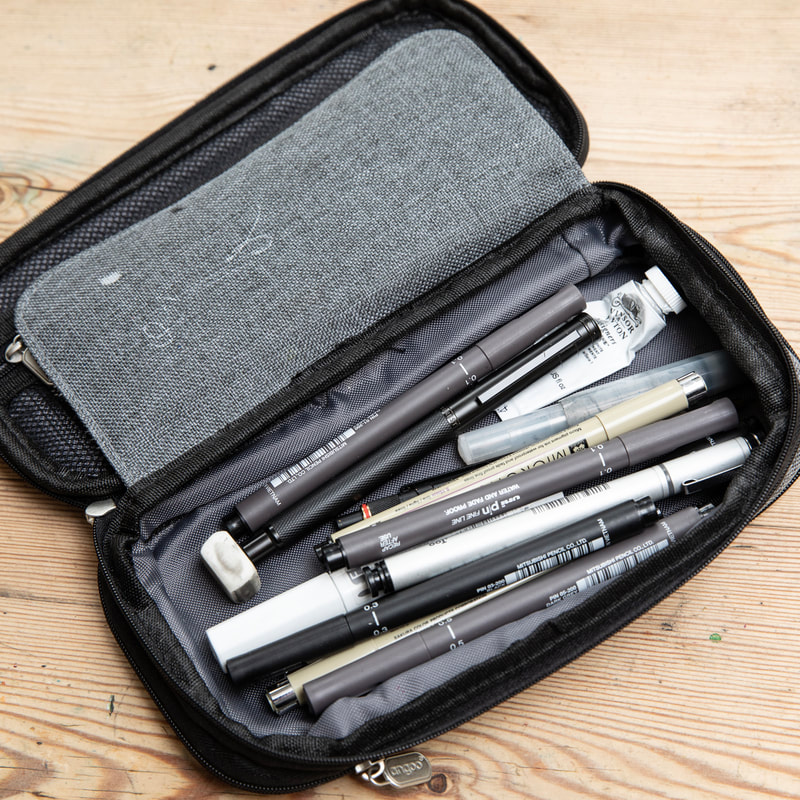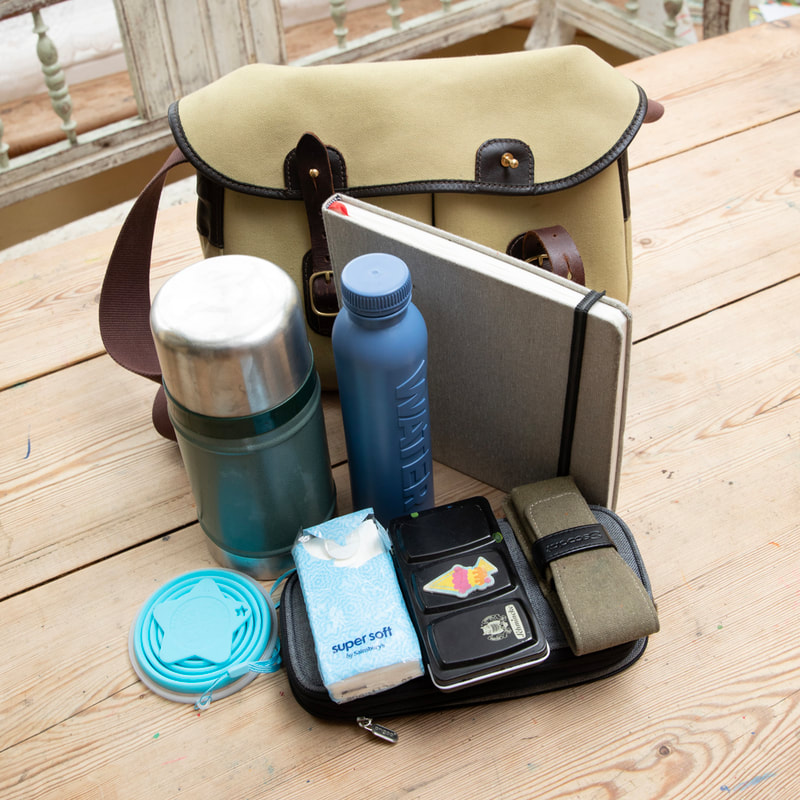What materials do I use?
Like a lot of artists, I probably have too much kit. Some stuff is bought out of necessity but some gear is ordered with an eye to experiment and explore new media. Mostly I found as I progressed that I’ve come back around to a simpler and a more lightweight way of working. Speaking to other artists and researching what they use is a great way to prevent wasting money on poor materials and also might give you the opportunity to try before you buy.
In today’s disposable culture I try and find materials with a lightweight environment footprint and high quality to give my artwork longevity.
Finally in this introduction I just want to say that you really don’t need a lot of kit to get drawing and creating art. My hyper-minimal Plein Air kit (outdoor drawing) can fit in a pocket and comprises of a tiny micro pallet, a pen, a brush pen and a sketchbook. Just four elements – see My Plien Air Kit
Like a lot of artists, I probably have too much kit. Some stuff is bought out of necessity but some gear is ordered with an eye to experiment and explore new media. Mostly I found as I progressed that I’ve come back around to a simpler and a more lightweight way of working. Speaking to other artists and researching what they use is a great way to prevent wasting money on poor materials and also might give you the opportunity to try before you buy.
In today’s disposable culture I try and find materials with a lightweight environment footprint and high quality to give my artwork longevity.
Finally in this introduction I just want to say that you really don’t need a lot of kit to get drawing and creating art. My hyper-minimal Plein Air kit (outdoor drawing) can fit in a pocket and comprises of a tiny micro pallet, a pen, a brush pen and a sketchbook. Just four elements – see My Plien Air Kit
|
Paper
I use loose sheets, blocks and sketchbooks and have tried many manufacturers but seem to return to my favourites. ST Cuthberts Mill make a High White paper (a much whiter white than usual paper) that I’m particularly fond of and it comes in many options both loose and in pad and block form. Also available in different weight either, 300gsm, 425gsm or the lovely 640gsm and different textures. Their range of Bockingford pads are also great and pretty cost effective. Arches blocks are very good and they also do a Bright White Aquarelle paper which is fabulous. I tend to order rather cheap sketchbook pads to use for testing and playing but these vary every time. Its really good have cheap and half used paper, offcuts even, on hand when painting. I often test my colour out on an offcut before applying them to the final piece. I even mix colours on a spare bit of paper on occasion especially if my palette is full. I never stretch paper as I either use thick paper or work on blocks. |
Pens
I do use fineliners but hate the waste. I draw in either different thicknesses or use black for main subject/foreground and dark grey for backgrounds. Most I use Uni pin fineliners or Micron fineliner and tend to buy then in packs of five once every couple of years.
Increasingly I find myself using either on fountain pen to do all the linework or a combination of two (typically a thin nib and then a fude nib)
My favourite fountain pens (I have about 15) would be;
I use all sorts of inks in these, some waterproof like the excellent Octopus Write and Draw inks and some water soluble.
Pencils
I use retractable pencils as I can’t be bother to sharpen them. I have a couple but my favourite is a Rotring 800.
I do use fineliners but hate the waste. I draw in either different thicknesses or use black for main subject/foreground and dark grey for backgrounds. Most I use Uni pin fineliners or Micron fineliner and tend to buy then in packs of five once every couple of years.
Increasingly I find myself using either on fountain pen to do all the linework or a combination of two (typically a thin nib and then a fude nib)
My favourite fountain pens (I have about 15) would be;
- Kaweco Sport EF nib (compact and light)
- Opus 88 Demonstartoe Eyedropper (huge ink capacity, never blocked, good for big hands)
- Duke Fude (the fude nib is great fun and can give thin and thick lines)
- Noodlers Ahab with FPR Ultra Flex nib (super flex calligraphy nib)
I use all sorts of inks in these, some waterproof like the excellent Octopus Write and Draw inks and some water soluble.
Pencils
I use retractable pencils as I can’t be bother to sharpen them. I have a couple but my favourite is a Rotring 800.
Inks
The ink I draw with the most is Platinum Carbon Black ink which is very waterproof when dry and gives a rich black covering. It comes in cartridges but I tend to buy one bottle which lasts about a year. I have used it with a mop brush to cover huge areas of a painting before which it does very well creating an even black covering.
Diamine do some great inks and Itheir sets offer good value for money.
Using ink to add colour to a piece can be a lot of fun. It can be used to create some amazing skies and depths of tone. Being dye based, rather than pigment based like watercolour, it can be a very different media. A great resource for all things inky is Nick Stewart
Paint
I have used a fair few types of watercolour paints but I finally created a Daniel Smith palette roughly based on Liz Steel’s palette advice. This was primarily because many of my favourite artist use Daniel Smith and it meant discussing colour a lot easier. There is a lot to learn about watercolour when you get below the surface. Granulation, transparency and staining all become more important as you learn. I did lot of colour swatching and mixing exercises which were very useful as I got to grips with watercolour.
Brushes
Often, I just take a small mop brush out with me painting and that’s fine, especially if I’m doing simple line and wash sketches. When In in the studio I generally have a pot of ten or so brushes varying from a huge mop to tiny detail brushes. But I can say honestly now that mostly I could do 95% of my painting with a set of three. This is one of the reasons I love travel sets. I have two of these and both are good for painting. I first bought the Escoda Green set but supplemented it with a small detail brush. This hasn’t been the best in terms of quality. I had to put a bit of tape on one of the brushes so the push fit has friction and also, I used glue to repair one when the steel cap came off. I’ve always looked after them and never left them sitting in water so that’s not great really. The second set are the Raphael Le Voyageur Travel Brushes. These are fabulous and the little mop brush that comes with the set is a peach.
Often, I just take a small mop brush out with me painting and that’s fine, especially if I’m doing simple line and wash sketches. When In in the studio I generally have a pot of ten or so brushes varying from a huge mop to tiny detail brushes. But I can say honestly now that mostly I could do 95% of my painting with a set of three. This is one of the reasons I love travel sets. I have two of these and both are good for painting. I first bought the Escoda Green set but supplemented it with a small detail brush. This hasn’t been the best in terms of quality. I had to put a bit of tape on one of the brushes so the push fit has friction and also, I used glue to repair one when the steel cap came off. I’ve always looked after them and never left them sitting in water so that’s not great really. The second set are the Raphael Le Voyageur Travel Brushes. These are fabulous and the little mop brush that comes with the set is a peach.
Bags and Storage
I have a small pen storage sack and if you want a lovely traditional sketching bag, like a Barbour bag, but at significantly less cost I can recommend Gunslip Bags ltd. They are a Welsh based company and do fine works. This one is the one of their shoulder bags.
Water
I tend to carry a bottle in my bag and used a small silicone collapsible cup. Alternately you can use a water brush pen. That is a cheap plastic brush with a water reservoir built in. A small aerosol bottle with water in is useful for wetting a large area or keeping it wet on a hot day.
Other important stuff
Tissues are not only important if you need a good cry but they are vital in water colouring to clean up unwanted paint as well as dry brushes. A good light source is pretty vital especially in winter. Investing in a decent work light will mean you can be more flexibly in term of when you can paint. A syringe is a useful tool for dispensing small amounts of ink (and filling a fountain pen) as is a pipette.
Masking and White pens
As well as masking tape I used masking fluid a fair bit. I personally like the SAA blue masking fluid as its easier to see. You can also use a masking fluid marker for doing little bits but I just use a rigger brush and give it a good clean afterwards. Finding a decent white pen has been hard. I have tried many types but ultimately what work best is a White Sakura Jelly Roll, size 10 and for brushing on I use Dr Ph Martins Bleedproof White.
I have a small pen storage sack and if you want a lovely traditional sketching bag, like a Barbour bag, but at significantly less cost I can recommend Gunslip Bags ltd. They are a Welsh based company and do fine works. This one is the one of their shoulder bags.
Water
I tend to carry a bottle in my bag and used a small silicone collapsible cup. Alternately you can use a water brush pen. That is a cheap plastic brush with a water reservoir built in. A small aerosol bottle with water in is useful for wetting a large area or keeping it wet on a hot day.
Other important stuff
Tissues are not only important if you need a good cry but they are vital in water colouring to clean up unwanted paint as well as dry brushes. A good light source is pretty vital especially in winter. Investing in a decent work light will mean you can be more flexibly in term of when you can paint. A syringe is a useful tool for dispensing small amounts of ink (and filling a fountain pen) as is a pipette.
Masking and White pens
As well as masking tape I used masking fluid a fair bit. I personally like the SAA blue masking fluid as its easier to see. You can also use a masking fluid marker for doing little bits but I just use a rigger brush and give it a good clean afterwards. Finding a decent white pen has been hard. I have tried many types but ultimately what work best is a White Sakura Jelly Roll, size 10 and for brushing on I use Dr Ph Martins Bleedproof White.
Conclusion
So that’s about it for now. This will all change I’m sure and I haven’t even mentioned half the stuff lurking at the back of the cupboard. That only gets pulled out occasionally for daring forays into the work of acrylics and gouache and other such fearful territories.
When I look at the art supplies I often think of the Character of Fran in the fabulous comedy series Black Books saying “but I must be musical ..…I have hundreds of CD’s.”
I hope you enjoyed this rather long piece.
So that’s about it for now. This will all change I’m sure and I haven’t even mentioned half the stuff lurking at the back of the cupboard. That only gets pulled out occasionally for daring forays into the work of acrylics and gouache and other such fearful territories.
When I look at the art supplies I often think of the Character of Fran in the fabulous comedy series Black Books saying “but I must be musical ..…I have hundreds of CD’s.”
I hope you enjoyed this rather long piece.
dougjartwork@gmail.com Copyright © 2024 Doug Jackson Artwork. All Rights Reserved


